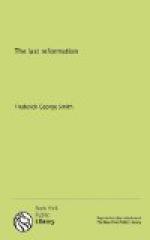The nature of the symbol itself fixes the interpretation. A woman must of necessity symbolize a church, but we must determine by the character of the woman whether or not the true church or a false church is represented. The woman of the vision was splendidly attired and evidently occupied a prominent place; for she is represented as riding on the beast, the political empire, thus directing its course; and she is also represented as sitting upon many waters, interpreted as “peoples, and multitudes, and nations, and tongues” (verse 15), denoting her wide influence over distant nations. She is not simply represented as a prominent person, however, but as a vile character. She is “a great whore,” “with whom the kings of the earth have committed fornication.” It is clear that in Scripture false, idolatrous worship is represented as whoredom (see 1 Chron. 5: 25; Ezekiel 16 and 23). Hence a false church is represented.
[Sidenote: Mother and daughters]
There is only one church that can fulfil the description, and that is the Church of Rome. Long has she delighted in calling herself the “mother church,” but centuries before she made this claim, the pen of inspiration affixed to her indelibly the title of “mother”—“MOTHER OF HARLOTS AND ABOMINATIONS OF THE EARTH.” She bore upon her forehead this inscription, together with the title “Mystery, Babylon the Great.” Other false apostate churches there are, but she heads the list and is the mother of them all. No wonder the apostle marveled when he saw this professed church of Jesus Christ defiled by the most abominable wickedness, in league with all the evil powers of earth, and, above all, “drunken with the blood of the saints, and with the blood of the martyrs of Jesus.” That Rome from the date she became firmly established in power has ever been a constant persecutor of the saints, the pages of all history abundantly attest. Even Rome’s ecclesiastical writers and historians themselves admit her use of force in destroying those whom she denominated heretics.
Revelation 17 covers the same period chronologically and ends at the same point of time as did chapter 13. Hence we should naturally suppose that it would also describe in some manner the power symbolized by the two-horned beast—Protestantism—as well as duplicate the description of the ten-horned beast—Catholicism. That the papacy is symbolized in chapter 17 by the corrupt whore sitting on the ten-horned beast, is too plain to need any particular demonstration. The other division of the apostasy is included under the term “harlots,” the daughters of the “mother” church. In our interpretation of chapter 14 we showed that the angel clearly applied the term Babylon to the worshipers of the second beast—Protestantism—as well as to those of the first beast. Therefore we must regard Babylon as a general term denoting the whole city of religious confusion, the mother and her harlot daughters being simply specific divisions.




